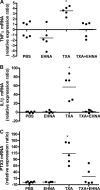Adenosine deaminase inhibition prevents Clostridium difficile toxin A-induced enteritis in mice
- PMID: 21115723
- PMCID: PMC3028843
- DOI: 10.1128/IAI.01159-10
Adenosine deaminase inhibition prevents Clostridium difficile toxin A-induced enteritis in mice
Abstract
Toxin A (TxA) is able to induce most of the classical features of Clostridium difficile-associated disease in animal models. The objective of this study was to determine the effect of an inhibitor of adenosine deaminase, EHNA [erythro-9-(2-hydroxy-3-nonyl)-adenine], on TxA-induced enteritis in C57BL6 mice and on the gene expression of adenosine receptors. EHNA (90 μmol/kg) or phosphate-buffered saline (PBS) was injected intraperitoneally (i.p.) 30 min prior to TxA (50 μg) or PBS injection into the ileal loop. A(2A) adenosine receptor agonist (ATL313; 5 nM) was injected in the ileal loop immediately before TxA (50 μg) in mice pretreated with EHNA. The animals were euthanized 3 h later. The changes in the tissue were assessed by the evaluation of ileal loop weight/length and secretion volume/length ratios, histological analysis, myeloperoxidase assay (MPO), the local expression of inducible nitric oxide synthase (NOS2), pentraxin 3 (PTX3), NF-κB, tumor necrosis factor alpha (TNF-α), and interleukin-1β (IL-1β) by immunohistochemistry and/or quantitative reverse transcription-PCR (qRT-PCR). The gene expression profiles of A₁, A(2A), A(2B), and A₃ adenosine receptors also were evaluated by qRT-PCR. Adenosine deaminase inhibition, by EHNA, reduced tissue injury, neutrophil infiltration, and the levels of proinflammatory cytokines (TNF-α and IL-1β) as well as the expression of NOS2, NF-κB, and PTX3 in the ileum of mice injected with TxA. ATL313 had no additional effect on EHNA action. TxA increased the gene expression of A₁ and A(2A) adenosine receptors. Our findings show that the inhibition of adenosine deaminase by EHNA can prevent Clostridium difficile TxA-induced damage and inflammation possibly through the A(2A) adenosine receptor, suggesting that the modulation of adenosine/adenosine deaminase represents an important tool in the management of C. difficile-induced disease.
Figures









References
-
- Barankiewicz, J., et al. 1997. Regulation of adenosine concentration and cytoprotective effects of novel reversible adenosine deaminase inhibitors. J. Pharmacol. Exp. Ther. 283:1230-1238. - PubMed
-
- Barreto, A. R., et al. 2008. Fucoidin prevents Clostridium difficile toxin-A-induced ileal enteritis in mice. Dig. Dis. Sci. 53:990-996. - PubMed
-
- Bartlett, J. G. 2002. Clinical practice. Antibiotic-associated diarrhea. N. Engl. J. Med. 346:334-339. - PubMed
-
- Blossom, D. B., and L. C. McDonald. 2007. The challenges posed by reemerging Clostridium difficile infection. Clin. Infect. Dis. 45:222-227. - PubMed
-
- Bours, M. J., E. L. Swennen, V. F. Di, B. N. Cronstein, and P. C. Dagnelie. 2006. Adenosine 5′-triphosphate and adenosine as endogenous signaling molecules in immunity and inflammation. Pharmacol. Ther. 112:358-404. - PubMed
Publication types
MeSH terms
Substances
Grants and funding
LinkOut - more resources
Full Text Sources
Research Materials
Miscellaneous

